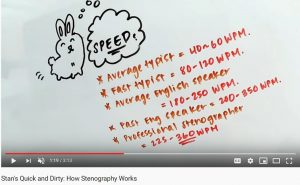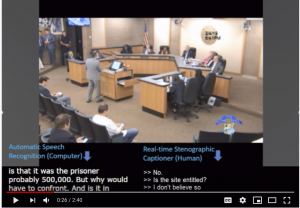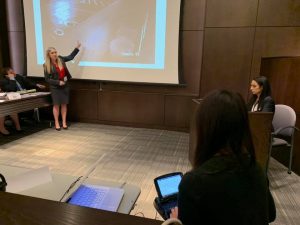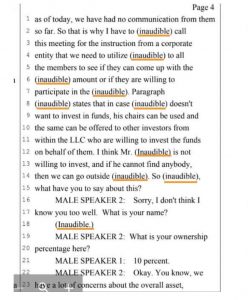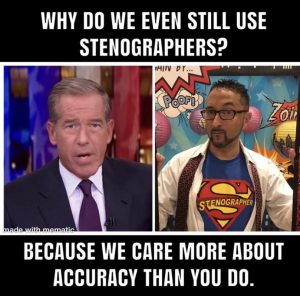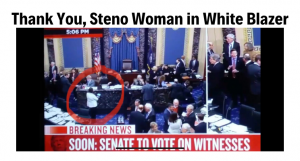
MSNBC – On January 31, 2020, during a live broadcast of the U.S. Senate impeachment trial of President Donald Trump, your news anchor, Brian Williams, commented on the proceedings with former Senator Claire McCaskill:
Mr. Williams: Can you explain the steno woman in the white blazer and why in 2020, in this electronic age, they still have a roving stenographer?
Ms. McCaskill: Not one, but two, and one on backup, and they wander through the back lobby behind the Senate chamber. They pick up their machines, and there are a number of them, and they change out in shifts; one comes in and both of them go for a while and they break. I don’t know why we’re still using an old-fashioned stenographer in the Senate. But it looks like to me they’ve upgraded it to digital at this point.
Mr. Williams: Yeah. It looks like she’s carrying a cash register.
Ms. McCaskill: Yeah. Yeah.“
This was followed by snickering and laughter. [1]
Disgraceful. Disrespectful. Unprofessional. Undignified.
NOT funny.
Mr. Williams: You minimized the crucial role and person of the courageous human stenographer who works diligently as a guardian of the record in a challenging, stressful job capturing the spoken word in high-profile events [2] like the impeachment trial of the president of the United States and provides verbatim, accurate, official transcripts to “steno woman“? Is that the best you can do?
And you equated the technologically advanced, specialized, chorded keyboard which is connected to a Computer-Aided Transcription (CAT) system to produce verbatim [3] transcripts from the stenographer’s precise finger placement of thousands of memorized shorthand word combinations with a “cash register“? [4] Seriously?
In all the years you have been an anchor, where do you think the official transcripts of depositions, court trials, and Congressional hearings come from that you and your MSNBC colleagues quote on the air?
FYI – The proper title of the irreplaceable [5], highly skilled stenographers who capture and produce the daily Congressional Record is Official Reporters of Debate. They use custom-made trays with straps that carry their very expensive steno machines to allow them the mobility to hear and capture every word spoken on the record.
Their myriad duties include:
…Listen attentively to all Senate floor activity in order to accurately report official debate and stray remarks made on the Senate floor.” [6]
Ms. McCaskill: As a member of the bar of Missouri, and especially during your 12 years as a Senator, did you ever speak with any of the Official Reporters of the United States Senate, (i.e., stenographers)? Certainly you have read a transcript or two of Senate proceedings and in your private practice?
Your “upgraded to digital at this point” comment is archaic. Stenographers have been providing immediate transcription of the spoken word via cutting-edge CAT technology known as “realtime” [7] (from shorthand to English) since the 1960s.
Q: Where do you think the words written on the bottom of the screen simultaneously as you and Mr. Williams spoke came from?
A: Live (human) realtime broadcast captioners providing closed captioning for the Deaf and Hard of Hearing.
Every word she’s speaking is being captioned accurately by an ‘old-fashioned’ stenographer, sent through multiple IP connections to encoders and then delivered in real time to both the TV and online stream of MSNBC’s broadcast.” [8]
FYI, Congressional reporters neither “wander” nor overlap each other. One reporter writes for 10-15 minutes and is replaced by another while s/he rushes to their office to transcribe what was reported. The impeachment trial consisted of several 12-hour days “on the record” into the wee hours, a grueling schedule for Senators but more so for reporters who are intently focused on capturing, memorializing, and producing the Congressional Record. Official Reporters’ work is not done until the Record is available online and in print just hours later.
Mr. Williams’ and Ms. McCaskill’s above exchange is the epitome of disrespect for a noble profession that dates back to 3500 B.C., when Sumerians began capturing the spoken word to preserve historical events. According to The Gallery of Shorthand:
The first verbatim shorthand writing machine in America was the 1879 Stenograph, invented by Miles Bartholomew.” [9]
Since 1879, stenographic machines and the professionals who use them have evolved and remain the most technologically advanced method of capturing the spoken word and producing a verbatim record. [10]
In other words, stenographers with those funny-looking machines (commonly known as court reporters) have used stenographic shorthand for over 140 years to write 200-300+ words per minute (wpm), faster than most people speak.
In 2015, Stanley Sakai, certified realtime stenographer and captioner, produced an educational 3-minute video, Stan’s Quick & Dirty: How Stenography Works, with over 400,000 views. [11]
Mr. Williams’ and Ms. McCaskill’s above exchange demonstrates ignorance of the high level of skill, intelligence, and education required to be a stenographer.
Sadly, they are not alone.
The increased use of voice-activated technology–Automatic Speech Recognition (ASR) and Artificial Intelligence (AI)–has led the general public and some legal professionals to believe that stenographers are on the verge of extinction. But savvy judges, litigators, and elected officials know that no audio machine, device, or app can replace the highly skilled, live stenographic court reporter.
Watch this shocking side-by-side 2-minute video of ASR vs. a human stenographic realtime captioner capturing the record at a live meeting.
“Which do you think provides accurate communication and meets the FCC quality standards?” [12] And which do you want at your meeting, deposition, hearing, conference, arbitration, or trial?
MSNBC: Please inform your staff about stenographers’ crucial role capturing a verbatim record of the spoken word in numerous diverse venues, including the chaotic Senate chambers, keeping a sharp eye and ear for those whose turn it is to speak while tuning out background noise, such as people entering and leaving, coughing, sneezing, rustling papers, etc.
Whether in Congress, a deposition room, at trial, arbitration, or just normal conversation, most people hear the gist of what is being said. Most (including attorneys) don’t listen to every word. So it doesn’t matter if they hear the entire word or sentence, especially when speakers mumble, have heavy accents, talk at the same time, or there are interruptions (e.g., someone sneezes in the middle of a comment or question). Most people get a basic understanding of what was said, or assume they do.
On the other hand, highly skilled stenographers spend thousands of dollars over several years of instruction and education and thousands of hours of specialized hands-on machine training to develop the acute ability to listen for every SYL-LA-BLE, write it verbatim, and read it back exactly as it was spoken.
Court reporters are legally and ethically bound to produce verbatim transcripts. In many states, they must abide by multiple state and federal rules of procedure and conduct. As irreplaceable guardians of the record, stenographers are passionate about the integrity of the record and committed to accuracy, confidentiality, impartiality, and accountability.
Reporters prepare in advance for depositions, trials, arbitrations, and other events through extensive research and development of job-specific terminology [13], with meticulous attention to detail to deliver the very best end product (e.g., instant rough drafts / realtime and the associated official printed transcripts). [14]
Most digital-audio recording personnel don’t undergo the intensive training that stenographers do, have no ability to read back, and conduct no research in advance. In states where there’s no government oversight, they have no accountability when there are errors.
Besides equipment failures, major issues with high-tech digital recording equipment include numerous gaps and missing text due to low audio, unclear speech, and background noise. [15]
Digital recordings are later handed off to remote transcriptionists who were not present and may live outside the U.S. Since they cannot see who was speaking, they face the often insurmountable challenge of not being able to correctly identify the speakers, especially when the recording is of poor quality, multiple voices speak at once (or incoherently), or background noise obliterates the speakers’ words.
Imagine what kind of transcripts your MSNBC staff would get if the U.S. Senate relied on digital recordings to capture the record when there are 100+ Senators in the spacious Senate chambers and they’re not all “mic’d up.” Likely what you see in the attached transcript page. Of what use are these transcripts peppered with (INAUDIBLE) parentheticals throughout?
“Courts (especially appellate courts) will be faced with a due process constitutional nightmare if inadequate, inaccurate, or nonexistent transcripts result in a mistrial.” [16]
Importantly, both digital recording personnel and remote transcriptionists are privy to highly sensitive testimony and information, such as proprietary intellectual property; Social Security numbers; drivers’ licenses; bank statements; medical and health insurance data; mortgage documents; death and birth certificates; divorce papers; etc. The potential liability is unfathomable.
MSNBC: Please read the brilliant article by Stanley Sakai, In an Age of High-Definition Digital Audio, Why Do We Still Use Human Stenographers?, published five days before this incident, where Stan provides statistics that answer Mr. Williams’ question: Why in 2020, the electronic age, does Congress still have “roving” stenographers?
“Microphones do not know when they are ‘not getting it,’ and thus, cannot regulate people’s sloppy speech habits. Simply handing off a recording to someone who can hear and type English doesn’t necessarily guarantee they will be able to understand everything. They aren’t able to see who is speaking, so it will be much harder for them to correctly attribute each utterance to its speaker. Moreover, unless they are highly trained, their verbatim-transcription skills may not be up to snuff … Junk-ass audio leads to junk-ass transcripts.” [17]
MSNBC: Please watch the video segment broadcast on The Rachel Maddow Show (TRMS), Thank You Court Reporters and Artists!, with this introductory language:
“Joy Reid expressed her appreciation on behalf of Rachel Maddow and the entire TRMS staff to the court reporters who go to great lengths to deliver the vital, timely court transcripts that inform the show…”
“The first order of business here at the show is to get transcripts ordered, stat, and this show gets them under some tight deadlines, hours of hearings, transcribed verbatim … Rachel and the entire TRMS staff would be lost without these guys.”
Clearly, Ms. Maddow and Ms. Reid understand the value of immediate verbatim transcripts and appreciate and respect the people who deliver them: “TRMS Salutes ‘Unsung Heroes‘ of 2018: Court Artists and Reporters.” [18]
I’m guessing Mr. Williams did not watch this segment.
Please educate your commentators so that they stop disrespecting the honorable profession of stenographic court reporting and the professional realtime stenographers, captioners, and mask/voice writers who deliver verbatim records of the spoken word – every day, all day long, all over the world.
So-called “old-fashioned” stenographers are the real MVPs [19] at Congressional hearings; arbitrations; trials; depositions; conferences; movie theaters; church services; and news, sports, theater, and many other live in-person and online events and venues. And that is why reporters cannot be replaced. [20]
Mr. Williams and Ms. McCaskill: As a result of your disrespectful, thoughtless comments and inappropriate laughter on 1/31/2020, you have ignited the global court reporting community, resulting in thousands of tweets and retweets; articles; Facebook, Instagram, and LinkedIn posts, shares and re-shares; calls, emails and letters to news and media outlets, including MSNBC, as well as to Ms. McCaskill’s offices, from stenographers, voice writers, captioners, CART providers [21], and court reporting associations and organizations. And let’s not forget the memes, including the gems on this page. [22]
So, thank you.
Mr. Williams: Before you disgraced yourself [23], I appreciated your calm, efficient, compassionate demeanor, which stood out in a sea of histrionic news talk shows. I turned to you for a fair, thoughtful summary or in-depth analysis of events.
Once again, you have the opportunity to make things right: Educate yourself, sincerely apologize, and show us the respect we deserve by devoting an entire show to give our honorable profession the opportunity to set the record straight by spotlighting and interviewing the irreplaceable, hard-working stenographers who dedicate their lives to guarding the integrity of the record.
Thank you for reading. We look forward to your response. We will be waiting, watching, and listening — to every word.
We are STENO, and we are here to stay.
Three weeks after I published the above article, MSNBC’s Rachel Maddow and Lawrence O’Donnell offered their on-air gratitude and praise to human stenographers, “miracle workers” with a “stunning” skill who work hard to capture every single syllable and provide accurate, same-day delivery of transcripts that become the legal record. They added that court reporters do not consider themselves heroes but are performing a public service, and that they will be at the gates of Heaven, alongside librarians and elementary school teachers. Thank you, Ms. Maddow and Mr. O’Donnell!
Editor’s Note – This article is republished with the permission of the author, Ana Fatima Costa ©. All rights reserved. First publication was on LinkedIn.
Resources:
[1] Facebook post with video of Mr. Williams’ and Ms. McCaskill’s commentary by stenographic reporter Paula Raskin of Raskin & Associates Court Reporting and Video (01/31/2020).
[2] Article by Lisa Desjardins, The Unseen Workers Who Guided the Senate Through Marathon Nominee Sessions, PBS NewsHour, PBS.org (02/09/2017).
[3] Speech before the U.S. Senate by Hon. Ted Poe, Getting the Words Right: Our Nation’s Court Reporters and House Clerks, Congressional Record Vol. 162, No. 32, (02/29/2016).
[4] Meme by Meredith Seymour, District 3 Court Reporter, Madison, Waukesha County, Wisconsin.
[5] Speech before the U.S. Senate by Rep. Rodney Davis, Recognizing the Irreplaceable Work of our Court Reporters During National Court Reporting and Captioning Week, Congressional Record Vol. 165, No. 29 (02/14/2019).
[6] Overview of Official Reporter of Debate job duties/requirements, United States Senate Office of the Secretary (01/05/2017).
[7] First of multiple references to realtime throughout this article refer to the instant transcription from shorthand into English (and other languages) of a stenographer’s shorthand notes visible in person or online on the viewer’s TV, computer, tablet, or smartphone. Source: www.CourtReporterEdu.org.
[8] Quote by Jordan Mucha, Realtime Captioner at VITAC, providing captioning services to CNN, CNN Headline News, all 3 network morning programs, MSNBC, CNBC, all 12 Discovery Networks, and more.
[9] Quote by Dominick M. Tursi, Official Court Reporter of U.S. District Court, Eastern District of New York, and Director of The Gallery of Shorthand, located in the Alfonse M. D’Amato Federal Courthouse, US District Court, 100 Federal Plaza, Central Islip, NY 11722.
[10] Mask writers, aka voice writers, began 80 years ago and also provide accurate transcriptions of events, including closed captioning for the deaf and hearing impaired. However, the focus of this article is stenographers.
[11] YouTube video published by Stanley Sakai, certified realtime stenographer and captioner, Stan’s Quick & Dirty: How Stenography Works (04/26/2015).
[12] Quote and YouTube video published by Dee Boenau, award-winning realtime stenographer and captioner at AmeriCaption, Automatic Speech Recognition (ASR) Captioning Compared to Human Stenographic Captioning (02/03/2019).
[13] LinkedIn article by realtime stenographer Janet McHugh, RMR, CRR, CLR, Help Me Protect Your Record, (02/07/2020).
[14] Court reporting student intern Esther Au, reporter of record at Golden Gate School of Law’s final mock trial, In Vino Veritas, In Wine There Is Truth (10/20/2019). Photo by Ana Fatima Costa.
[15] Article by Ana Fatima Costa, Protect Your Clients: “Digital” Recorded Depositions Revealed, Legal by the Bay blog and Bulletin print newsletter, Bar Association of San Francisco (01/17/2019).
[16] Quote by former paralegal Beryl Vaughn, educator and consultant to forensic psychiatrist and forensic psychologist experts, Forensic Expert Pro.
[17] Article, sample transcript and quote by Stanley Sakai, CCR (Washington State certified shorthand reporter), NCRA Certified CART Provider, realtime captioner, and Vox Media software engineer, In an Age of High-Definition Digital Audio, Why Do We Still Use Human Stenographers?, The Startup, Medium.com (01/26/2020). Photo here of Stan realtime-captioning an event.
[18] Video by MSNBC’s national correspondent Joy Ann Reid, Thank You Court Reporters and Artists!, MSNBC.com (12/28/2018).
[19] LinkedIn article by realtime stenographer Kellie Smith, CCR, RPR, CRR, Washington State Official Court Reporter, Old-Fashioned Stenographers: The Real MVPs (02/08/2020).
[20] Article Why Court Reporters Cannot Be Replaced…According to a Neurosurgeon, The Ink Slinger (10/27/2015).
[21] Communication Access Realtime Translation (CART) Captioning is the instant translation of the spoken word into English text (realtime) by stenographers using a steno machine and laptop with CAT software. They provide the instant word-to-text translation on a laptop, tablet, or smartphone for deaf or hard of hearing persons at various venues.
[22] Meme by Richard Scire, Official Court Reporter for the 12th Judicial Court of Florida of his twin brother, Michael Anthony Scire, Lead Official Court Reporter for the 12th Judicial Court of Florida.
[23] Article by correspondent Rory Carroll, NBC Suspends Brian Williams for Six Months Over Iraq Helicopter Story, The Guardian (02/11/2015).
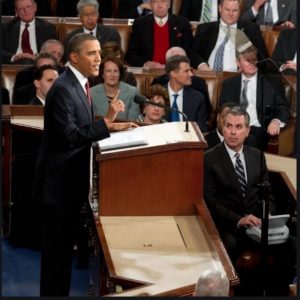 Additional resource (not quoted above): Whereas: Stories from the People’s House, Hanging on Every Word by Art. Includes an interview of realtime stenographer, former Chief Reporter Joe Strickland, Office of Official Reporters (July 23, 2019). This photo of Joe on the record was taken at President Barack Obama’s State of the Union Address, 2012.
Additional resource (not quoted above): Whereas: Stories from the People’s House, Hanging on Every Word by Art. Includes an interview of realtime stenographer, former Chief Reporter Joe Strickland, Office of Official Reporters (July 23, 2019). This photo of Joe on the record was taken at President Barack Obama’s State of the Union Address, 2012.
#ProudStenographers #WeCareAbouttheRecord #Stenography #StenoistheGoldStandard #IntegrityoftheRecord #GuardiansoftheRecord #accuratetranscripts #verbatimtranscripts #MSNBC #BrianWilliams #ClaireMcCaskill #StenoMVPs #ReportersGettheLastWord #Superheroes


